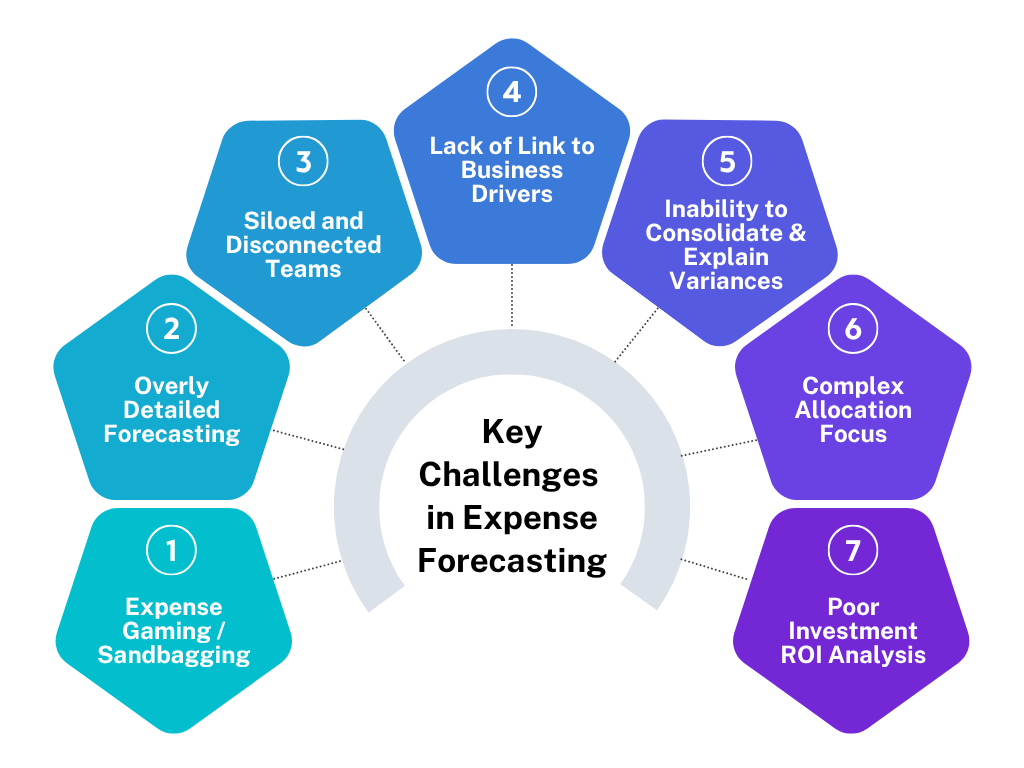Confusing forecasting with target setting derails accountability and performance — FP&A must treat them as distinct...

Over the years, I have been struck by how many companies across industries have dedicated teams or, in some cases, designated team members focused on forecasting expenses with relatively similar processes. While a lot of processes around forecasting for revenues and balance sheets differ widely from industry to industry, expense forecasting practices are relatively similar.
During my career across FP&A, I have noticed some of the following challenges when it comes to expense budgeting and forecasting: a significant amount of effort, time and resources is spent trying to forecast expenses down to the last detail. More work doesn't always equal more accuracy. Extra work can drive a false sense of precision. Expense forecasting also involves a fair amount of business partner interaction both in terms of getting updated inputs and ensuring accountability when expenses run higher or lower.
In fact, according to the 2025 FP&A Trends Survey, 46% of FP&A time is still spent on data collection and validation, and only 44% of organisations rate their forecasts as accurate, highlighting a disconnect between effort and impact. And while forecasting is a core FP&A process, yet 55% of companies still require more than five business days to produce a single forecast [1].
The Most Common Pitfalls
Despite varying industries and tools, most organisations fall into the same traps when it comes to expense forecasting. These issues persist regardless of company size or structure.
Figure 1 below outlines seven common key challenges that limit the effectiveness of expense forecasting.

Figure 1
What's Driving the Complexity?
Some practices I have found that lead to wasted work are:
Significant expense gaming/sandbagging. There is typically a lot of expense gaming/ conservative forecasting done by both business and finance teams to get additional resources and not have a negative variance in Budget/Forecast. Additionally, having a conservative forecast helps business/finance spend money without the same level of scrutiny.
Budgeting/ Forecasting expenses at a very detailed level. Some examples of this include cost centre-level forecasting name and by-name forecasting. Such practices add a lot of effort and resources to compile and don't necessarily add value, as companies and businesses generally target to be at a certain level of expenses.
Siloed and specialised expense teams that only talk to each other and rarely influence real expenses. Fractured FP&A teams, some of whom are onshore vs offshore – some near business vs farther from business, lead to further complexity. This can lead to the same thing being communicated to multiple teams at different times in the process.
This leads to a lack of knowledge of the correlation between expenses and business drivers. In one of my early experiences, the first budget produced by an expense group had expenses growing by more than 5% while the business was shrinking revenues.
Inability to consolidate themes and explain variances simply. Consolidating expense themes across businesses/ companies is challenging due to their complexity and different reasons. Simplifying expense variances is done further up the business/ company, leading to more work.
Too much time is spent on allocations and challenging allocations that do not change the company's total expense. For example, in one of my earlier organisations, we had a really complex allocation system within one of our businesses with multiple allocation runs to finish the process. While this process improved the quality on lower-level business returns, the underlying assumptions were often qualitative. Additionally, the process strained the entire organisation, with multiple finance and business people working on the allocations.
Investments in new hires/ teams/ advertising &marketing, and other areas without adequate review of returns and ensuring returns are reflected in P&L's and balance sheets. One of the key expense FP&A tasks should be investment analytics – both past and future. However, due to the complexity of the budgeting and forecasting process, less time is spent on value-added activities.
Practical Solutions and Implementation Steps.
Some thoughts on improving expense budgeting and forecasting:
Guidance earlier in the process on expectations around expense growth/decreases. Strong guidance from Corporate on acceptable expense changes (increase/ decrease) is good hygiene. It sets expectations with the business unit on what is acceptable and desirable. Some organisations adopt a wait-and-see approach to see what a business unit submits, but that increases the frustration when feedback is used to find better expense outcomes.
Setting expectations with Senior management on acceptable variances. Finance leadership and business management need to focus on the underlying causes of variances, focusing on what is controllable and likely to impact the future, vs. a one-off. It's good to set expectations that finance is not trying to forecast every single line item at every cost centre, so some natural variance is inevitable.
Communication:
Firstly, starting with business communication — it is good to do a monthly read-out with the business on where expenses for the month ended, what is in the forecast and what the business and the supporting finance team expect to see as variances to the Forecast/ Budget.
Internal finance communication — especially in large expense teams is key. As organisations grow larger, they have specialised expense teams, meaning the FP&A team is two or more steps away from the business. While this creates advantages of scale and a neutral third-party forecast, it doesn't tackle questions like how the business can get back to Budget/ Forecast. Also, the flavour of volume-driven expenses and business hires/reductions can get lost. It is important to have a clear and regular line of communication between the business FP&A team and the COE. Leaders should also prioritise open and non-hierarchical lines of communication. If there is an expense issue, it doesn't need to go from one chain of command to another.
HR communication — Having HR present when communicating actuals, budget, and forecasts with the business can be useful. They can flag key hires/ leavers, and it gets them involved in managing the overall profitability of the business. In one of my past organisations, the finance team partnered well with HR, and we set up a simple net new hire budget. HR could work with different teams to hire new people. There are always hires and attrition in flight; this puts the onus on HR to manage the headcount number. It also reduces forecasting complexity by centrally doing one net new hire number rather than forecasting individual hires.
Monthly actuals: Teams should spend enough time analysing monthly results, seeing what moved from the trend, what the controllable expenses were, and what surprises there were. This time spent is well-rewarded during forecasting, as you have a good idea about the latest trends.
Complexity reduction: Expense models can become very complex. In some cases, there is a wait to load HR data that helps forecast the next few months. The size and complexity of the HR data might not make the effort worth it. With people comp in particular, the trend is your friend, and analysts and teams should embrace run rate forecasting. Forecasting at a granular level increases complexity, not accuracy. In general, I'd recommend that teams spend time understanding the trend, seeing what can move the trend (like hires/ attrition) and then forecasting it on that basis. Pre-populating the next few months with the past months' results with an adjustment toggle might be the most efficient forecasting method.
Reducing allocation complexity: The allocation process can be a source of unnecessary complexity. I still remember a quote from one of my support units who mentioned that their budget would be out of date by August of the previous year due to the long cycle of coming up with a Budget, then syndicating it with the business and finalising it. In general, simple allocation processes should be the rule with a focus on what is controllable/ influenceable by the businesses.
Simplyfing processes and reducing FP&A teams. The more people get involved in expense forecasting, especially consolidation, the more they can create unnecessary work and add to the burden. The larger the expense team, the more time is spent on analysing and tracking variances that can't be influenced. Having smaller, impactful and analytical expense teams that look at the big picture can help unlock efficiencies.
Spending more time and effort tracking key investment performance and supporting related analytics. Reducing the complexity of forecasting should mean that FP&A teams have more time to do value-added activities, such as monitoring the performance of investments and using that to inform future investment decisions.
Focusing on outcomes, or what the expense trends are signalling and what actions can be taken. Ideally, increase time working with business partners, focusing on transparency with risks and opportunities. It is important to push the business partners to be realistic in terms of what can be achieved, what decisions need to be taken and how the forecast should reflect them.
Conclusion: From Complexity to Clarity
In conclusion, expense forecasting shouldn't be as time-consuming and painstaking as it typically is. To improve the quality and efficiency, focus should be on the following areas:
- Simplifying processes to eliminate unnecessary work
- Set clear and easy-to-defend targets early in the process
- Accepting positive and negative variances is normal
- Reducing forecasting and team complexity, embracing simple practices such as run rate forecasting and add-on expenses to develop budgets and forecasts
- Communicate clearly and openly within the FP&A organisation as well as the larger business.
- Reallocate time to working constructively with business partners
- Focus on impactful and behaviour-changing analytics
- Move towards value-added analytics such as investment outcomes and strategic support.
Source
1. 2025 FP&A Trends Survey: From Ambition to Execution: How Leading FP&A Teams Turn Insights into Impact
Note: The Article represents personal views and does not reflect experiences in a single company
Subscribe to
FP&A Trends Digest

We will regularly update you on the latest trends and developments in FP&A. Take the opportunity to have articles written by finance thought leaders delivered directly to your inbox; watch compelling webinars; connect with like-minded professionals; and become a part of our global community.






